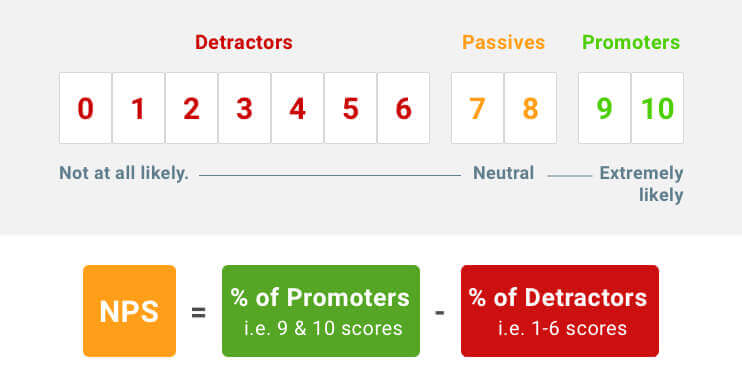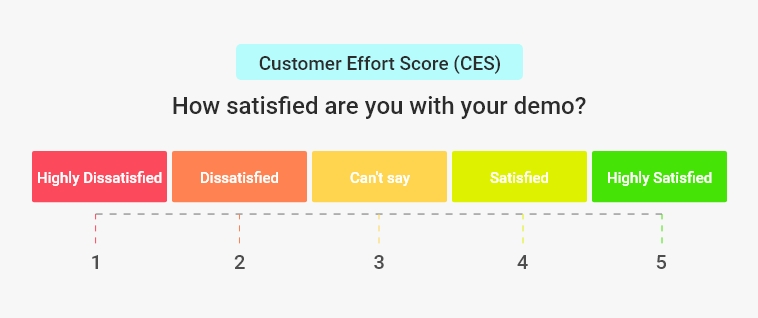
If you are here, you are probably searching for ways to measure customer experience.
The concept of customer experience may not be new, but not everyone is aware of how to create strategies to embrace it.
The fast-paced market imposes a lot of challenges for businesses and, they tend to lose a firm grasp on creating delightful customer experiences while focusing on other elements. Capturing feedback from customers to understand their experience is one way. However, the road to success is not that easy!
A successful customer experience is one of the key elements of every organization’s growth. The same becomes unavoidable in the case of a SaaS organization.
Customers who have a smooth experience with your products/services tend to become loyal. They further recommend you to their friends and family. Depending on how easy their journey has been, a lot of elements are involved which determine the success rate of CX.
But do you know which strategies work best to measure the success rate of customer experience? In this blog, we will explore everything about customer experience metrics, how to measure customer experience, and its importance.
Why You Should Measure Customer Experience
In the words of Peter Drucker,
“If you cannot measure it, you cannot manage it.”
Delivering an exceptional customer experience is the demand of the time which every business must embrace to grow and stay on top. Digital transformation has impacted a lot of business elements, and delightful customer experience has become a new way to attain a competitive advantage.
Delivering exceptional customer service and delightful experiences are sure-shot ways to win every customer’s trust. This will further help you measure the overall performance of the strategies that you have implemented.
Let’s discuss some key reasons why you should measure customer experience.
1. It Helps You Increase Sales
Establishing better customer relationships results in a delightful customer base. As we discussed earlier, a delighted customer is your brand advocate. That means you have more chances of potential leads being nurtured for successful conversions. Better brand recognition results in better sales opportunities.
2. It Helps You Understand Customers’ Expectations
One of the reasons why businesses fail is the gap between what customers expect and what businesses deliver. When you measure customer satisfaction, you will understand their likes and dislikes, which is an important metric. Remember, a business succeeds when it understands its customers’ needs and provides them with the products and services that meet their needs.
3. It Helps You Understand Customer Acquisition Challenges
Increased sales depend on acquiring more customers, but that’s not an easy game. Focusing on customer retention and satisfaction can help you here. However, you shouldn’t lose track of your existing customers while acquiring new ones. Existing customers bring in constant revenue in the form of repeat buying, and they become brand advocates.
4. It Helps You Enhance your Brand Image
Brand image and reputation put your company on top. If your customers think of you as a solution to their problems, it is more than half the battle won. Your goal is to maintain a positive image and enhance brand value. This also involves keeping a constant tab on negative words about your business. Thus, measuring CX will equip you with corrective strategies to reduce dissatisfaction and establish a positive brand image.
Read more: Your Ultimate Guide to Brand Perception
Customer satisfaction and loyalty are largely dependent on customer experience. We all know a satisfied customer not only returns but also advocates for you with others. Not paying attention to customer feedback is like ignoring possible chances for further improvement and revenue loss. And you may experience a dip in customer retention.
Investing in a customer experience dashboard helps businesses track overall satisfaction throughout the journey, starting from the pre-sale to the end.
It takes a lot to convince someone to buy your product. And it is even harder to turn a customer into a loyal customer who will continue spending money on your products. This can only be done when they develop a positive brand image and emotional connection.
Ways to Measure Customer Experience With CS Metrics
Among the easiest ways to measure customer experience is by Voice of the Customer metrics tools, such as NPS; however, one thing to note here is that this tool comes with certain limitations.
Usually, we measure customer feedback either in aggregate, through segmentation, or after isolation at the customer’s individual touchpoints. Though it may sound like an easy ride at first, it’s bumpy.
Sometimes, measuring customer experience and acting on it can be challenging. You may fail to collate the customers’ feedback, and thus you will have difficulty measuring the overall journey experience of the customer.
The data collected from measuring the customer experience is used in multiple ways, putting a company at the forefront of the competition. Such as:
- It can help you improve your product as per the customers’ demand.
- It can help you with your saas marketing strategies.
- It can help you improve your sales strategy.
It may sound like an easy ride at first, but it’s bumpy. Sometimes, measuring customer experience and acting on it can be challenging.
- Structuring strategies based on bad data
- Dealing with frustrated customers
- Poorly crafted surveys
- Unable to act on the feedback received
Above mentioned are some key areas of risks where one might struggle. However, if you haven’t started a feedback loop with your customers, you are missing a lot.
Ensure that sending multiple surveys over and over to the customers is again not a good practice of collecting feedback. This can lead to survey fatigue and reduced response rates. Let’s have a look at the ways to improve customer experience measurement.
1. Set Customer Experience Measurement Priorities
Having a solid framework of customer experience measurement is an important step in determining the overall performance of the customer journey. Running a measurement framework without focusing on the customer journey/experience may lead you to failure. Therefore, keeping a track of the touchpoints of the customer journey in sync with the business goals is an important step.
The experience measurement framework should focus on the customer goals, for example, bill payment, service/product upgradation, etc. You can study customer journey data to understand any pain points or filter out driving elements and move towards bringing improvements.
After identifying and prioritizing the crucial phases of the entire customer journey experience, it gets easier to chalk out the key metrics for customer experience and KPIs.
Read more: Importance of Customer Experience in 2023
2. Right CX Metric at Right Touchpoint in Customer Journey
Each customer comes with a unique set of challenges and perceptions. And this cannot be analyzed using a single way of experience measurement. Usually, businesses tend to use CSAT or NPS tools to analyze the journey experience. However, using a single channel cannot yield the best possible results.
Imagine giving the same solution to every customer without understanding their problems…
It is evident that different customers have different requirements and expectations at every phase of the journey. Thus, using a single metric is not a wise decision.
Let’s take this hypothetical situation.
You are expecting a replacement for the shoes you ordered online, and you had issues with the size. You contact customer support, and the executive tells you that there was a delay in the replacement. It would take three more days. You feel disappointed since you needed those shoes badly for some important event. Before disconnecting the call, the customer support executive asks if you’d recommend the business to others (NPS). Forget about recommending; with this experience, you won’t even purchase again from there.
Read more: A Step-to-Step Guide to Provide Exceptional Customer Support
It’s better to first focus on customer experience analytics to identify and implement actionable insights based on the end-to-end customer journey. You can only deliver a seamless experience when you understand the overall customer journey and the pain point throughout the process.
3. Capture Customer Feedback at Right Time at Right Channel
Note that the customers may hesitate to provide proper feedback due to certain limitations, such as time. Avoid asking for feedback at every stage of the journey. Feedback can be asked during any major interaction or touchpoint.
Therefore, you must ensure that your customer experience measurement framework doesn’t consume too much time and is easy to process. However, at the same time, you also need to focus on capturing customer feedback from their desired channels of communication at the right time.
Let’s take the same situation stated above in the 2nd point. Imagine you are on the call for more than 20 minutes, and at the end, the customer support executive transfers you to the IVR to capture feedback. Now, this can be frustrating that you were already on call for 20 minutes, and now you will have to spend more with the IVR.
In this case, email or SMS should be the optimal options for capturing feedback. However, you must know your customers’ preferred channels using customer journey analysis. A customer journey analytics framework can further help you channel and automate engagement at any touchpoint of the journey.
4. CX Metrics Calculation for Behavioral Segmentations
As discussed above, every customer comes with a unique set of behavioral patterns. Moreover, not every customer will have a similar contribution toward the success of your business. Therefore, you better align your CX measurement framework towards the customers who bring high value.
Let’s take an example here. The same shoe company has to identify the customers who experienced several unattended problems. Then the company has to find out the customers who discontinued their services after contacting customer service.
Based on these behavioral interactions and segmentations, the company decides the important CX metrics and aligns further improvement plans.
Right from the moment a customer starts a journey with your product to the final stage, the CX team should collect all the data and create actionable reports. This supports measuring customer experience by providing in-depth data. For this, you can utilize CX data dashboards to keep track of CX metrics in real-time.
Read more: Difference Between CSAT, NPS & CES
Top 5 Important Customer Experience Metrics
CX experts use a variety of experience metrics to analyze the success rate of customer experience. Here are the top five CX metrics.
1. Net Promoter Score (NPS)
NPS is used to measure customer loyalty. Using this tool, you can find out how loyal your customers are and if they will recommend you to their friends or family. Net Promoter Score is among the top favorite choices when it comes to measuring customer experience. The simplest and the most organized method, NPS includes simple survey questions that can be anything like
How likely are you to recommend us to your friend or family on a scale of 0-10?
Customers provide answers on a scale of 0-10 depending on their experiences.
There are three categories of respondents.
- Promoters (9-10)
- Passives (7-8)
- Detractors (0-6)

Using NPS, you can identify how many customers are loyal to your brand and have become ambassadors.
The basic rule to calculate NPS is by subtracting the decorators from the promoters.
NPS is sometimes also referred to as the King of customer experience metrics due to its simplicity and ease of use. Customers find it easy to respond to the survey, and companies find it easy to track and analyze the data captured from the customers. Most of the big business giants use NPS to measure customer loyalty considering it an industry standard.
Read more: How to Turn Detractors into Promoters
2. Customer Satisfaction (CSAT)
Every organization wants to know how satisfied its customers are with its products and services.
This metric provides an average satisfaction score of the customers. It involves a survey that the customers have to respond to based on the experience they had with the company. The experience can be anything like a customer support call experience, product return experience, delivery rescheduling experience, etc.
CSAT surveys are usually based on a five-point rating system from Highly Satisfied to Least Satisfied. You can take required decisions based on the customers’ feedback.
The best time to send a CSAT survey is right after the customer’s interaction with your product. You can ask them the following question:
How satisfied are you with our product/service on a scale of 1-10?
You can even ask this question to the customer after any touchpoint in the journey. You can frame your questions according to the situation and the customer’s journey. This may look like a simple survey; however, it gives you an insight into the customer experience.
Read more: 100+ Customer Satisfaction Survey Questions & Examples
3. Customer Effort Score (CES)
As the name suggests, CES highlights how easy it was to assemble and use the product for the customer.
Every customer wishes to easily and effortlessly connect with you without spending too much time, be it at any touchpoint during the customer journey. Moreover, a customer should easily be able to purchase, understand or get answers. This ultimately increases customer loyalty.
Poor experience results in sales drop since customers no longer plan to buy based on the interaction and switch to your competitors. Moreover, these customers even put negative reviews online.
You can use this score to identify customer churn. Here’s a common question you can ask your customers
How easy was it to contact our customer support executive?
- Very Difficult
- Difficult
- Neither
- Easy
- Very Easy
This metric provides the easiest way to capture customer feedback to understand their experience. This transactional metric helps you understand how easy it is for the customers to find a solution. You can eliminate all the friction points, understand the customer effort score and improve customer experience.

Gartner, in a report, states that
“94% of customers with low-effort interactions plan to repurchase in comparison to 4% who experienced high effort scores.”
Read more: How to Measure Customer Experience Success
4. Customer Lifetime Value (CLV)
This metric tells you the worth of every customer, i.e., the total economic value a customer brings to your organization over the year-long connection. It is one of the most useful tools which helps businesses create customer acquisition strategies.
CLV is among the most used tools to calculate the money a customer spends on a company, buying its products or services. This calculation also informs how much the business invests in customer retention.
A good customer experience score means a good customer lifetime value. However, if you notice that the customer is spending less or is dissatisfied, that’s where you need to start working. It helps businesses understand if the customer has reduced spending/buying from you. The metric enables CX managers to structure strategies for increasing the lifetime value of every customer.
The basic formula for calculating the CLV score is
Customer Value x Average Customer Lifespan
In the above formula, customer value is the average purchase value multiplied by average purchase numbers.
Read more: 21 Infallible Tips to Increase Customer LIfetime Value
5. Customer Retention Rate
This metric highlights the number of customers who have left purchasing from you and number of customers still purchasing from you over a time period.
Using this customer experience measurement metric, you can identify the friction in the customer journey. This means you can track when a customer stopped associating with you, whether after a week or a month. Thus, once you get to know this, you can frame your strategies accordingly to retain customers.
A high retention rate means you have higher repurchasing and high referrals.
You can calculate customer retention rate through various methods. You can subtract the churned customers from the loyal customers over a period of time.
One more way to determine the retention rate is by calculating the number of loyal customers, for one particular time against the other. This is a simple formula.
Retention Rate = % of loyal customer in X time period / % of loyal customers in Y time period
So, if your churn rate is 20%, then your retention rate is 80%. This tells how fruitful your efforts are in keeping the customer happy and coming back.
Other than these, there are some more KPIs for customer experience, such as customer health score, customer support ticket trends, customer journey analytics, etc. By calculating all these customer experience KPIs, you can easily learn how and why your customers are leaving you, their health score, lifetime value, etc.
Measure Customer Experience to Enhance Customer Satisfaction
By now, you must have understood the importance of measuring customer experience and how it influences other parameters, such as customer retention, customer satisfaction, churn rate, etc. Businesses largely focus on customer journey analytics to understand customer experience. They invest huge amounts of time and resources so that they can improve their customer experience.
For a smooth customer experience, you must create an experience measurement that focuses on the customer journey. That way, you will be able to track down the pain points of the customers and understand the loopholes.
The key to delivering a delightful customer experience is proactively listening to your customers and understanding their queries. Based on these insights, you can create strategies to improve this overall process and deliver delightful customer experiences. A delightful customer is a happy and loyal customer.
FREE. All Features. FOREVER!
Try our Forever FREE account with all premium features!









